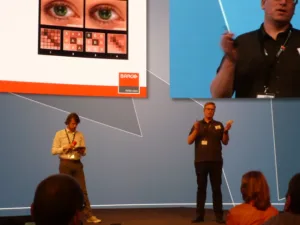Barco is one of Lang’s partners, supplying projectors, LFDs and infrastructure products. Alexis Skatchkoff and Abbe Westerlundh are engineers at the firm and were talking about the company’s new developments.
Barco was not the first company with a 4k projector outside of the cinema market, because it didn’t feel that the technology at the time was right for its customers. The only available chips were large and expensive 3DLP DCI-4k units. In addition there was no 1:1 pixel sampling; no 4:4:4 colour support; and latency was too high (above 15ms).
Texas Instruments’ UltraHD chip was the solution. It is a more affordable device, which can be used in 1- or 3DLP projectors – and, a big plus, means that the projectors can be used with existing lenses.
Barco “believes in 12-bit”. Processing is currently 10-bit, but they said that 12-bit is required for new lamp-based and lamp-free projectors. The company, according to Skatchkoff and Westerlundh, also believe that it will be ready for 8k projection – which will be here in two years’ time, they predicted!
As with 4k , Barco was not the first to market with a lamp-free projector. When these first appeared, they were not bright enough, too expensive and lacked colour. The company is now working on a new light source with better colours than today’s laser phosphor projectors – the same one shown at BIRTV in September (Barco’s Laser Snags BIRTV Award). This projector will have a low total cost of ownership and long lifetime, thanks to Barco’s new cooling technology.
At ISE next year, Barco will show its new laser phosphor projector and a 4k model – but I didn’t need to wait that long, as the laser prototype was in the Barco Suite at the Lang Academy. It is a laser phosphor model (with a phosphor colour wheel), able to project a 790″ image! It has 2048 x 1080 resolution and covers the DCI-P3 colour gamut.
The laser projector’s components were housed in a chassis from Barco’s C-Series, but this will not be the final design.Barco also mentioned that it is developing a pixel-shifting technology to achieve UltraHD resolution – but it is not like JVC’s eShift.
Outside of the Suite, Barco’s EC-50 video wall controller was being demonstrated. This product, launched two weeks ago and due to be shown at ISE, uses a ‘Wing’ concept – there are no processors inside, and a connection to a PC is required. However, Lang has developed its own small module which adds processing power and can be slotted into the controller, to make it a stand-alone solution. The controller has several rows of physical buttons, many of which can be remapped, and a 14″ 10-point touchscreen. A new switcher,called the S3, was also shown. This is like the E2 that was at ISE 2015, but smaller.

